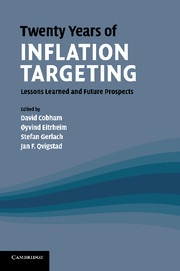Book contents
- Frontmatter
- Contents
- List of figures
- List of tables
- List of contributors
- 1 Introduction
- 2 Welcome remarks: a Norwegian perspective
- 3 Reflections on inflation targeting
- 4 Inflation targeting at twenty: achievements and challenges
- 5 Inflation targeting twenty years on: where, when, why, with what effects and what lies ahead?
- 6 How did we get to inflation targeting and where do we need to go to now? A perspective from the US experience
- 7 Inflation control around the world: why are some countries more successful than others?
- 8 Targeting inflation in Asia and the Pacific: lessons from the recent past
- 9 Inflation targeting and asset prices
- 10 The optimal monetary policy instrument, inflation versus asset price targeting, and financial stability
- 11 Expectations, deflation traps and macroeconomic policy
- 12 Heterogeneous expectations, learning and European inflation dynamics
- 13 Inflation targeting and private sector forecasts
- 14 Inflation targeting, transparency and inflation forecasts: evidence from individual forecasters
- 15 Gauging the effectiveness of quantitative forward guidance: evidence from three inflation targeters
- 16 Macro-modelling with many models
- 17 Have crisis monetary policy initiatives jeopardised central bank independence?
- 18 Inflation targeting: learning the lessons from the financial crisis
- 19 The financial crisis as an opportunity to strengthen inflation-targeting frameworks
- 20 ‘Leaning against the wind’ is fine, but will often not be enough
- 21 Inflation targeting, capital requirements and ‘leaning against the wind’: some comments
- Index
18 - Inflation targeting: learning the lessons from the financial crisis
Published online by Cambridge University Press: 05 October 2010
- Frontmatter
- Contents
- List of figures
- List of tables
- List of contributors
- 1 Introduction
- 2 Welcome remarks: a Norwegian perspective
- 3 Reflections on inflation targeting
- 4 Inflation targeting at twenty: achievements and challenges
- 5 Inflation targeting twenty years on: where, when, why, with what effects and what lies ahead?
- 6 How did we get to inflation targeting and where do we need to go to now? A perspective from the US experience
- 7 Inflation control around the world: why are some countries more successful than others?
- 8 Targeting inflation in Asia and the Pacific: lessons from the recent past
- 9 Inflation targeting and asset prices
- 10 The optimal monetary policy instrument, inflation versus asset price targeting, and financial stability
- 11 Expectations, deflation traps and macroeconomic policy
- 12 Heterogeneous expectations, learning and European inflation dynamics
- 13 Inflation targeting and private sector forecasts
- 14 Inflation targeting, transparency and inflation forecasts: evidence from individual forecasters
- 15 Gauging the effectiveness of quantitative forward guidance: evidence from three inflation targeters
- 16 Macro-modelling with many models
- 17 Have crisis monetary policy initiatives jeopardised central bank independence?
- 18 Inflation targeting: learning the lessons from the financial crisis
- 19 The financial crisis as an opportunity to strengthen inflation-targeting frameworks
- 20 ‘Leaning against the wind’ is fine, but will often not be enough
- 21 Inflation targeting, capital requirements and ‘leaning against the wind’: some comments
- Index
Summary
Over the past year the United Kingdom's Monetary Policy Committee has responded to the dramatic deterioration in the economic outlook with an equally dramatic easing in monetary policy. Bank rate was cut by 4.5 percentage points in just six months and by 1.5 p.p. in November 2008 alone. That was the largest cut for twenty-five years and is twice the size of the reduction made by any other G7 central bank in the past eighteen months. The MPC also voted to purchase £125 billion of assets financed by the issuance of central bank money – an amount equivalent to around 9 per cent of UK GDP.
The scale of that easing took many by surprise, and some of the decisions may, at first blush, look rather courageous. Devotees of the British television show Yes Minister may recall that Jim Hacker, the hapless minister, became very nervous whenever Sir Humphrey suggested that a decision of his was ‘courageous’. Central bankers can have similar instincts. When faced with big decisions, there is a temptation for caution to prevail: do interest rates really need to be moved by that much? Why not wait and see before resorting to the use of unconventional instruments?
Indeed, in the past the MPC has tended to move rates in relatively small, sequential steps. I would argue, though, that this is because, for much of the period since the establishment of the MPC, the outlook for inflation evolved relatively gradually.
- Type
- Chapter
- Information
- Twenty Years of Inflation TargetingLessons Learned and Future Prospects, pp. 424 - 427Publisher: Cambridge University PressPrint publication year: 2010
- 3
- Cited by



